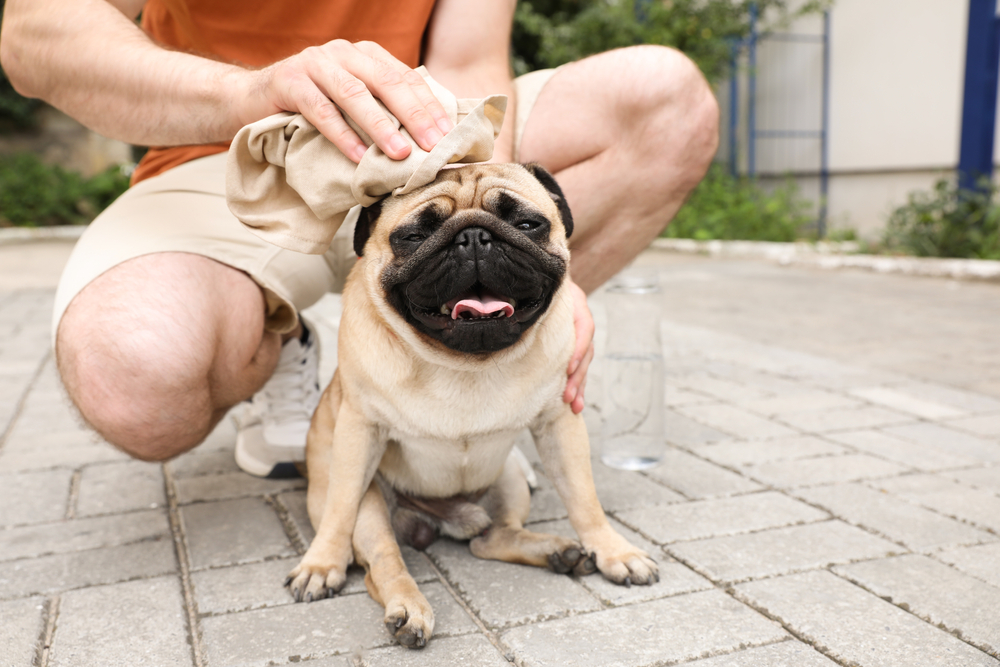Summertime is meant to be enjoyed with friends and family, four-legged pals included. However, your pet can run into all sorts of summer trouble and you must be prepared to keep them safe during warmer months. Follow our team’s guide for summertime safety, so you and your furry friend can make the most of the warm weather.
#1: Swap out your pet’s water frequently
Dirty water that has been sitting in the scorching sun all day will not appeal to your pet, who must stay hydrated, so swap out their water for clean, cool, fresh liquid frequently. Ready access to fresh water also helps keep your pet from lapping from the pool and ingesting chlorine and other chemicals.
#2: Stick to shaded areas for pets
Your pet can easily become sunburned or overheated in direct sunlight. Cats with white or light-colored fur are also at risk for developing squamous cell carcinoma, a type of skin cancer triggered by excessive ultraviolet radiation.
If your four-legged friend walks on sun-soaked asphalt, they likely will burn their paw pads, which may seem tough, but can rapidly become burned and blistered. Before you walk along unshaded pavement, try holding the back of your hand against the ground for 10 seconds. If you can’t, the pavement is too hot for your pet, and you should seek out grass or dirt trails, or find an alternate shaded route.
#3: Leave your pet at home
Does your dog jump with excitement when you grab your car keys? If so, leaving your adventure-seeking pooch behind is difficult, but safe in your climate-controlled home is their place to be. Leaving your pet in the car can cause them to rapidly overheat, despite the windows being rolled down and the car being parked in the shade. If you leave your pet in a running, parked vehicle, they can accidentally turn off the car, roll down the windows and escape, or bump the heating and air knobs.
#4: Outfit your pet in a safety vest
Not every pet knows how to doggy paddle, and your furry pal may panic if they fall in deep water. If you plan on taking your pet for a day on the lake or a dip in a friend’s pool, ensure your four-legged friend wears a safety vest to keep them afloat. Try out the vest first on dry land to ensure a good fit, and give your pet time to learn to move comfortably.
#5: Use pet-safe insect repellent
With summer fun come insect bites and stings. Various pests that can attack your furry pal and potentially transmit disease also enjoy the warmer summer temperatures. Protect your pet from biting and stinging bugs with pet-safe, DEET-free insect repellent. DEET and certain essential oils are popular ingredients in insect repellents, but they can cause serious health problems in pets. Instead, keep your pet safe with a veterinarian-approved parasite preventive and insect repellent.
#6: Brush your pet regularly
No matter how thick or long your pet’s fur, you should brush them regularly to remove dead fur, prevent matting, and keep skin healthy. A tangle- and mat-free hair coat insulates your pet against hot weather by trapping air that is similar to their ideal body temperature next to the skin. Flattened, matted fur prevents heat from dissipating, and your pet will more likely overheat.
#7: Block your pet from the grill
The grill is a source of temptation for your furry pal, with the aroma of roasting meat wafting in front of their nostrils, and tantalizing juices dripping onto the charcoal. While trying to lick a flaming chunk of charcoal is certainly dangerous, snagging hunks of meat off the grill is also a hazard for your pet. Bones, skin, fat, and heavy seasonings all pose a threat to your four-legged friend, so block their access to the grill and its offerings.
#8: Provide your pet with sun protection
Pets, especially light-colored pets with thin hair, can get sunburned. Focus on coating sunscreen on the sensitive skin on their nose, ears, and around their face where fur is usually sparse. Use a pet-friendly sunscreen, and follow the package’s directions to ensure your four-legged friend is protected the entire time you are outdoors.
#9: Check your pet’s identification
If you plan on hiking, camping, or traveling with your pet this summer, check that their identification is all set. Ensure collar ID tags are securely fastened, and legible with current contact information, and that the microchip registration company has your up-to-date phone number on file. More pets spend more time outdoors during the summer, so more become lost, making proper identification essential for a happy reunion.
#10: Watch your pet for overheating

Pets can overheat quickly in hot and humid weather, but mild conditions can also pose a threat. Monitor your pet closely while playing outdoors, and bring them inside to cool down at the first hint of overheating.
Heatstroke signs in pets include:
- Heavy panting
- Excessive drooling
- Lethargy
- Disorientation
- Vomiting
- Diarrhea
- Collapse
While any pet can fall victim to heatstroke, take special care if your pet is overweight, flat-faced, or has a cardiac or respiratory condition.
With proper precautions and supervision, you and your pet can enjoy wonderful adventures this summer season. However, if your pet runs into trouble, our Animal Clinic of Council Bluffs team is here for you—give us a call.






Leave A Comment